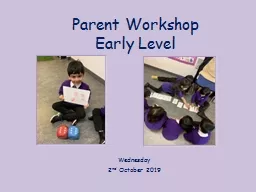

Wednesday 2 nd October 2019 Number Word Sequences Children need lots of practice when learning the meaning of before and after Use the pre number concept of before between and after in daily living situations such as ID: 785336
Download The PPT/PDF document "Parent Workshop Early Level" is the property of its rightful owner. Permission is granted to download and print the materials on this web site for personal, non-commercial use only, and to display it on your personal computer provided you do not modify the materials and that you retain all copyright notices contained in the materials. By downloading content from our website, you accept the terms of this agreement.
Slide1
Parent WorkshopEarly Level
Wednesday2nd October 2019
Slide2Number Word Sequences
Children need lots of practice when learning the meaning of “before” and “after”.Use the pre number concept of before, between and after in daily living situations such as:Lining the children up and asking them who comes before the others in the line.Using the children as a human number line and asking the following:Who has the number before…?Who has the number after…?
Who has the number between…?Children will be introduced to forward and backward number word sequences.
We were each given a number vest. We had to put ourselves in order!
Slide3Number word sequences
Forward Number Word Sequences (FNWSs)
Copying and saying short forward number sequences (start from all different numbers)
Saying alternate numbers 1,
2
,3,
4
,5,
6
Saying the next number 6,7,8,
9
Saying the next 1, 2 or 3 number words forwards 1 2 3
4 5 6
Saying the number after 17
18
Backward Number Word Sequences
As above but counting backwards
Slide4NumeralsChildren need to be immersed in number- numbers associated number names and corresponding values for each number. Activities could include the following:
Numbers on a number line- which numbers are missing?Which is greater, smaller?Can you find examples of numbers, number names in our class, school environment, home?Look at car number plates, what numbers can you see?I’m going to start counting from 6 and I’m going to count to this number( show number and number name), can you tell me when to stop?
Danny put all the mixed up post it notes in the right order! He had to recognise numerals and know about number order to be successful!
Slide5K Set D
5
How many?
How do you see it?
Slide6SubitisingSubitising is an essential part of developing Number Sense. By looking at a group of items, children can start to develop an understanding of how a number is made up.
Perceptual Subitising- is the amount you can instantly recognise without counting, usually up to 5 or 6.Conceptual Subitising-chunks a larger amount into smaller values
eg. 7 as 5 and 2 or 3 and 4.Children should be introduced to rectangular arrangements first ( show 10 s frames) then linear, circular and scrambled or random patterns.
What do you see, how did you see it?
Ibrahim recognised 6 straight away on the dice! Using a dice is a good way to develop our subitising skills at home.
Slide7Subitising
Slide8How to
subitise
Slide9Start with patterns In order
1
Regular / Domino Patterns
Slide10How do you
see it?
What do
you see?
2
Regular / Domino Patterns
Slide113
Regular / Domino Patterns
Slide124
Regular / Domino Patterns
Slide135
Regular / Domino Patterns
Slide146
Regular / Domino Patterns
Slide15Counting
Counting activities should form part of daily maths warm up activities.When counting objects, each object must be counted and given just one number name.The objects counted should be counted in a fixed order (1,2,3,4…)Children need to be aware that the last number used gives the number of objects in that set. (cardinality)The arrangement of the objects does not affect how many in the set. (conservation of number)
Aiza
and
Shahzain
know to count each object once!
Slide16Daily counting activities and resources
Slide17We can count anywhere!
Here are some photographs of us counting sticks and leaves outside!
Slide18Place ValueImportant to develop a strong sense of 10 and provide lots of opportunities to partition numbers in different ways.
Children should have a solid foundation of the “fiveness of 5” before moving on to partitioning within 10.The concept of zero is usually harder than counting and other early number concepts.
Slide19Building number sense
Slide20Building number sense
Slide21Useful Websiteshttps://www.topmarks.co.uk/learning-to-count/teddy-numbers
http://www.crickweb.co.uk/ks1numeracy.htmlhttps://www.topmarks.co.uk/learning-to-count/blast-offhttps://www.topmarks.co.uk/learning-to-count/gingerbread-man-gamehttps://www.topmarks.co.uk/learning-to-count/blast-offhttps://www.topmarks.co.uk/learning-to-count/ladybird-spots
Slide22Activity Groups Group 5
Aiza AfzalEesa AhmedHassan AhmedAyman
Al ObaidPip Gaizley-Gardiner
Group 2
Alaiyna
Bilal
Shayan
Farrukh
Saif
Ali
Hussain
Seher
Ul
Haq
Rohan
Singh
Group 3
Ibraheem
Javaid
Shanzay
Malik
Shahin
Salah
Mohammed
Nawaz
Group 4
Zainab
Shahzad
Hassan
Tahir
Sami
Usman
Daanyal
Zamir
Sahar
Javed
Group 1
Rohaan
Ahmed
Naba
Akhtar
Maaz
Aslam
Shahzain
Imran
Ibrahim
Shahzad
Group 6
Hishaam
Alam
Ibrahim Ali
Qailah
Ali
Ibrahim Amin
Mohammed Ibrahim